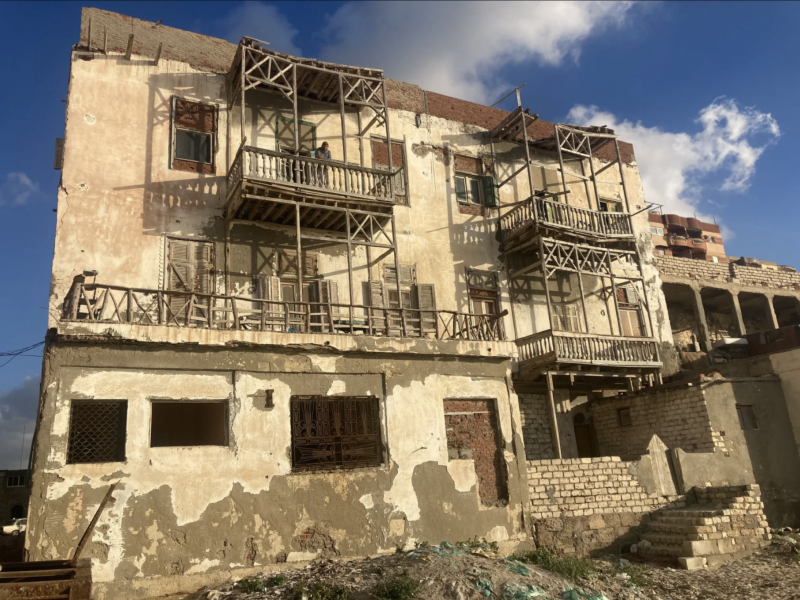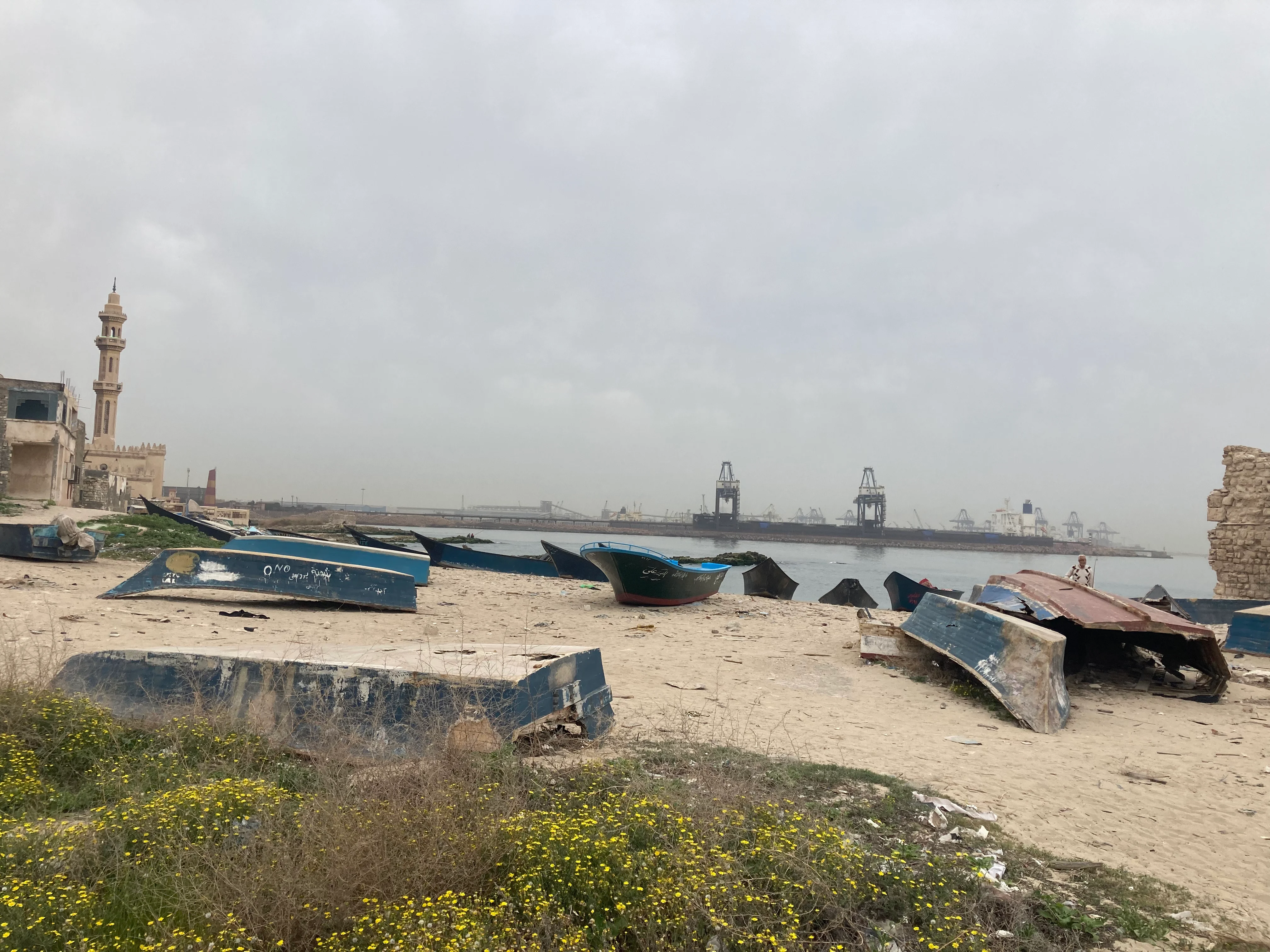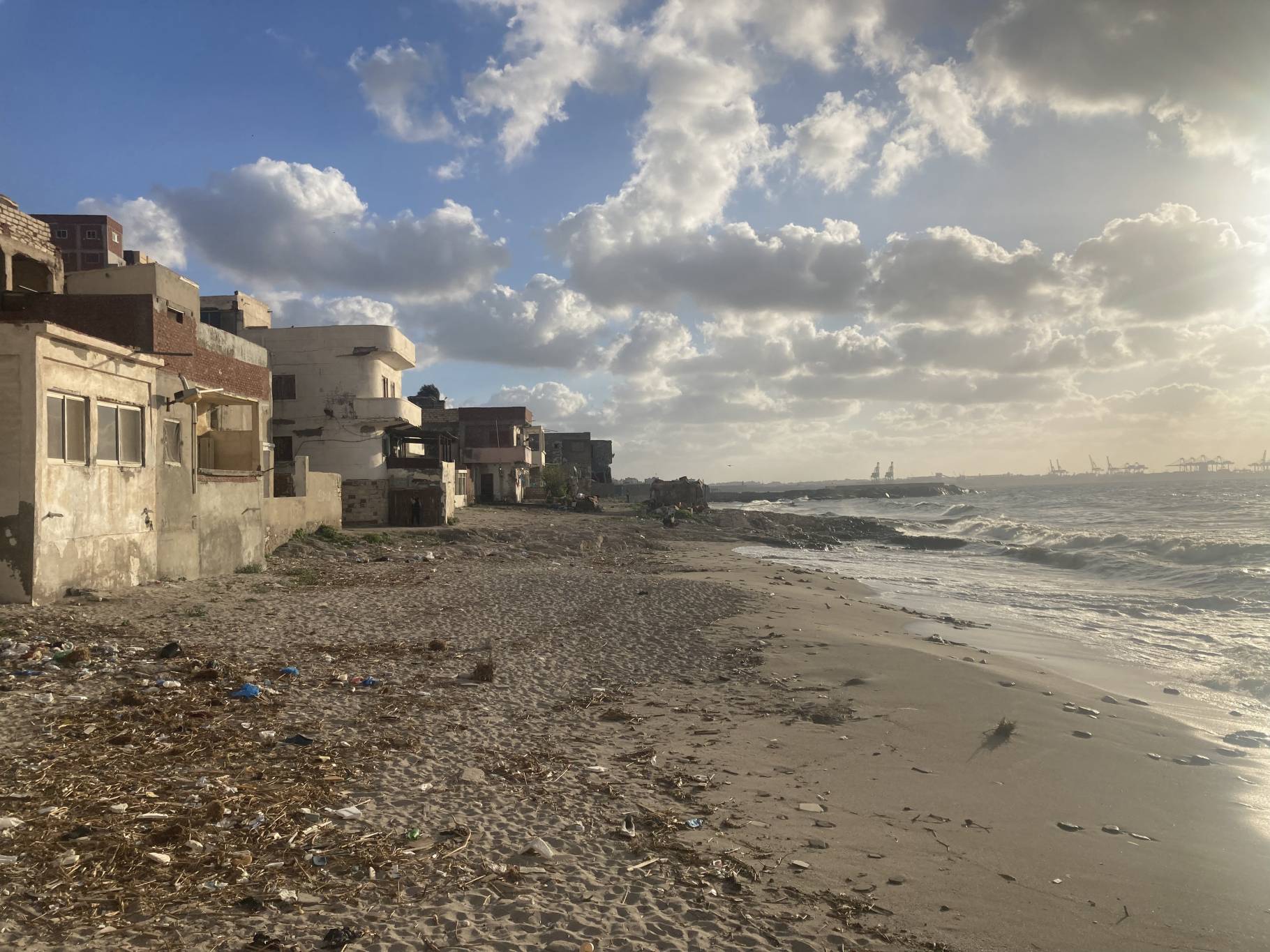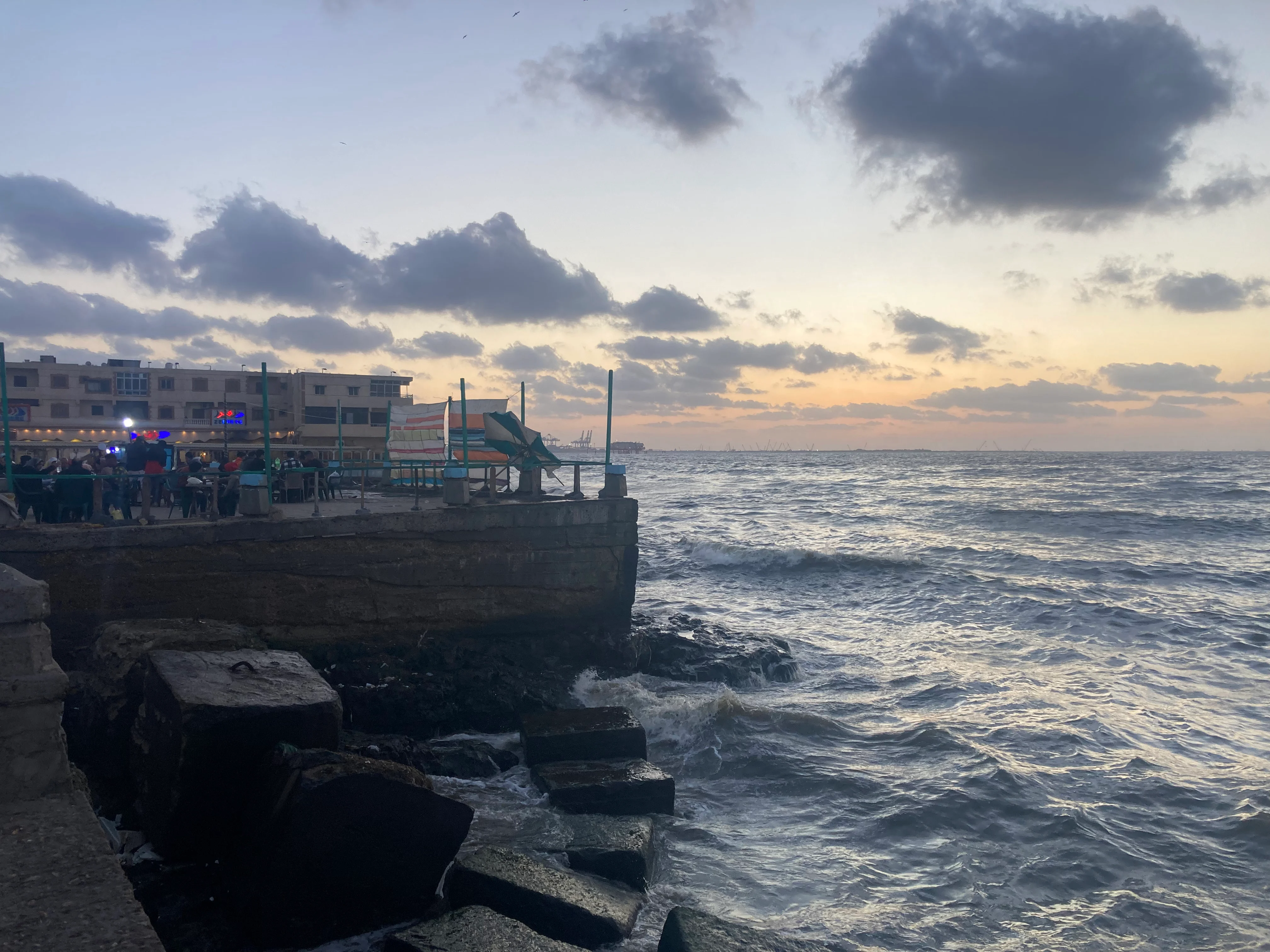
The "Red Lokanda" seen from a beach in al-Max, April 6, 2024. (Credit: Martin Dumas Primbault)
“Egypt’s Venice” has become a shadow of its former self. Most of the fishermen's traditional dwellings have disappeared along the narrow canal that divides the village of al-Max in two, at the western end of Alexandria.
Only a few ruins and the turquoise-painted boats in the small fishing port between Lake Mariout and the Mediterranean Sea remain there.
With confident steps, Yasser* climbed down the rubbish-covered hillside leading to his boat. “Before, these were houses, our houses. Now there’s nothing but ruins and garbage,” said Yasser* the fisherman, pointing to the shore with his chin.
A few years ago, modest brick huts spread out along the water’s edge. They were the pride of the few thousand inhabitants of the community.
Sitting on the deck of his canoe, barely larger than a raft, the young man looked disgusted at what has become of the village, where he spent 33 years “without ever leaving,” he said.
“Before, there were children bathing and there was life. Now we only use the canal to park our boats. People used to talk about Egyptian Venice. But where is it now? They’ve taken everything. It’s all gone. Al-Max is dead; it’s over.”
A port that must carry weight
In April 2020, state-sponsored bulldozers disturbed the peace of this small village-like neighborhood that is known to all Alexandrians. A third of the al-Max village, including the 228 houses along the canal, was razed and 1,500 families were displaced.
At the time, the Egyptian government cited the need to protect residents from flooding, which was becoming increasingly frequent due to the rapid rise in sea levels that threatened the Mediterranean coast.
“It’s true that some houses have collapsed in recent years,” said Yasser, “but was it really necessary to destroy everything?”
The government’s answer is clear. Announced in 2015, the Alexandria Great Port project aims (among other things) to connect the two ports of Dekheila to the west of al-Max and the port of Alexandria to the east.
Using bulldozers, the Egyptian government aims to include Alexandria among the biggest ports in the Mediterranean. It plans to extend its surface area by 344,000 square meters by constructing six new terminals and 22 additional quays. The project’s total estimated cost is $250 million.
Sandwiched between the two on a two-kilometer strip of coastline, the village had to disappear.
 Dekheila beach with the harbor in the background, March 28, 2024. (Credit: Martin Dumas Primbault)
Dekheila beach with the harbor in the background, March 28, 2024. (Credit: Martin Dumas Primbault)
The fishermen and their families have been rehoused in impersonal concrete towers built a hundred meters away, on the seafront. But this compensation is far from satisfying them all.
Rejecting any opposition, the government is determined to end informal urban settlements known in Egypt as ashawi’yat by 2030. Launched in 2019, the “Haya Karima” [Arabic for decent life] program is one of the military regime’s flagship development projects.
To do it, the method is almost always the same and often brutal. Inhabitants are asked to move into mass-produced new houses, sometimes miles from where they used to live, before the bulldozers arrive to clear the way for the property developers.
This scenario has been played out across the country over the past decade, at the instigation of a government obsessed with its forced modernization programs.
On rare occasions, what seems to be an agreement is reached with the residents, as was the case with some of the Maspero Triangle’s residents. The latter was a working-class neighborhood in the heart of Cairo that was eventually razed to the ground in 2018.
‘Everything will disappear’
In al-Max, the population was not consulted. “These houses don’t suit us. They’re tiny, and we have no balcony or services. Around here, the supermarket is small and the pharmacies have all closed. On top of that, we have to pay 750 pounds a month in rent [the equivalent to about $24], whereas we were the owners of our homes in the past,” said the young Egyptian.
He vehemently opposes the power of Marshal-President Abdel Fattah al-Sisi, who is behind this forced displacement. “He says he wants to bring us a decent life, but I can’t see it in al-Max,” he added on condition of anonymity for fear of reprisals.
 In al-Max, the Mahmoudiya canal where the houses now destroyed were located, April 6, 2024. (Credit: Martin Dumas Primbault)
In al-Max, the Mahmoudiya canal where the houses now destroyed were located, April 6, 2024. (Credit: Martin Dumas Primbault)
Leaning against the bridge's railing overlooking the fish market, a man who declined to be named pointed to the small block of houses still standing before the sea. He lives here with his family, six people in all.
“It's all going to disappear. We’re in the area that the government wants to reclaim for its new port project, so we have to leave, despite ourselves,” said the father in his forties, once behind the wheel of his car, safe from eavesdroppers.
A few months ago, a government official came to take a census of the neighborhood’s inhabitants. “He asked how many people lived there, took measurements, then left without explaining. Nobody knows what’s going to happen to us or where we’re going,” he said.
On March 21, a decision signed by the transport minister and published in the Official Gazette listed the planned evictions in the neighboring villages of Dekheila and Minet al-Bassal.
A 20-page appendix listed the addresses of “areas to be expropriated and reallocated for the benefit of the Alexandria Port Authority.”
The list includes schools, medical centers, post offices and detached houses. The one concerning al-Max could be made any day now.
A heritage in danger
Yasser expressed his fear that he would have to move again. Another humiliation. “They kicked us out once and they want to do it again. This time to the other side of the town, away from where we make our living, the sea and the fish. But they keep telling us that the project is a necessity for the country, so we’re not allowed to say anything,” he said.
As always, the authorities pledged a sum to compensate expropriated residents. The president insisted on this need during his last visit to the area. On paper, it is a colossal sum of no less than 1,753 million Egyptian pounds, or almost $37 million.
“But nowhere else will I be able to find a house that is that good, with this view and this fresh air coming inside. It’s priceless. Nothing beats the spirit in this house,” said Tamer al-Tabakh. He inherited a six-room apartment in one of al-Max's landmark buildings, the Red Lokanda.
This four-story wooden hotel was built 200 years ago right on the beach in a Greek-Islamic style. Now in a state of disrepair, this place remains for all inhabitants an emblem of the history of the village founded in 1820, when the Mahmudiyya canal was built.
“Like the lighthouse, the two mosques that line the coast and the ruined fort at the entrance to Dekheila are threatened,” said Ahmad Hassan, a resident.
 The beach in front of the "Red Lokanda" at al-Max, near Alexandria, Egypt, with the port of Dekheila in the background, April 6, 2024. (Credit: Martin Dumas Primbault)
The beach in front of the "Red Lokanda" at al-Max, near Alexandria, Egypt, with the port of Dekheila in the background, April 6, 2024. (Credit: Martin Dumas Primbault)
The Alexandrian expressed his frustration while holding the wheel of his cab, an old black and yellow Lada typical of Egypt’s second city.“The government should have rebuilt identical houses, like the ones that existed before, and allowed the fishermen to grow. It’s their job to preserve the beauty of the place. I used to come here to enjoy the scenery. That’s over now. The only people who are going to benefit from this project are the state and the port companies. The others can go to hell,” he said.
In 2007, a so-called urban harmony law introduced the concept of preserving historic buildings into Egyptian legislation. Since then, a division of the Culture Ministry has been responsible for drawing up a list of buildings in each city, the demolition of which is strictly forbidden.
“The problem is that this law involves loopholes that lawyers know all about and use to get around the rules. Of the 1,300 buildings listed in Alexandria, at least 200 were demolished despite everything,” said Mohamed Adel Dessouki, 46, assistant professor of architecture at the Arab Academy for Science, Technology and Maritime Transport in Alexandria.
Prophecy
Along with other architects, urban planners and political activists, he took up the fight to preserve heritage in 2011, at the heart of the Arab Spring, under the aegis of a group called Save Alex.
In the anarchy that reigned at the time, some voracious developers took advantage of the security forces’ lack of organization to illegally demolish historic buildings on land that could be exploited for profit.
Through sit-ins and demonstrations, activists succeeded in stopping this savage destruction for a time. “But from 2016 or 2017, our activities were no longer tolerated following the regime change in 2013 and a different political climate in the country. It was no longer possible to mobilize in the same way. It became very difficult, even dangerous. And many of the buildings we thought we’d saved were demolished later on,” recalled Dessouki.
 One of the cafes on the al-Max corniche, April 6, 2024. (Credit: Martin Dumas Primbault)
One of the cafes on the al-Max corniche, April 6, 2024. (Credit: Martin Dumas Primbault)
“In al-Max, it’s neither a historical site nor a place for tourism or entertainment. But for Alexandrians, it’s still a district steeped in memory, as many movies were shot there,” said the professor.
They include Bolteya al-Ayima (2008), which depicts the struggle of a fisherman’s wife against the appetites of an investor determined to turn the area into a luxury resort for yacht owners. Alone against all odds, she tries to prevent the bulldozers from entering the village, but to no avail.
More than 15 years after its release in theaters, the scenario seems like a prophecy. “You’d feel that the government gets inspired by blockbuster films in running the country,” said the most sarcastic fisherman at the al-Max fish market.
*Name was changed.
This article was originally published in L'Orient-Le Jour. Translated by Joelle El Khoury.